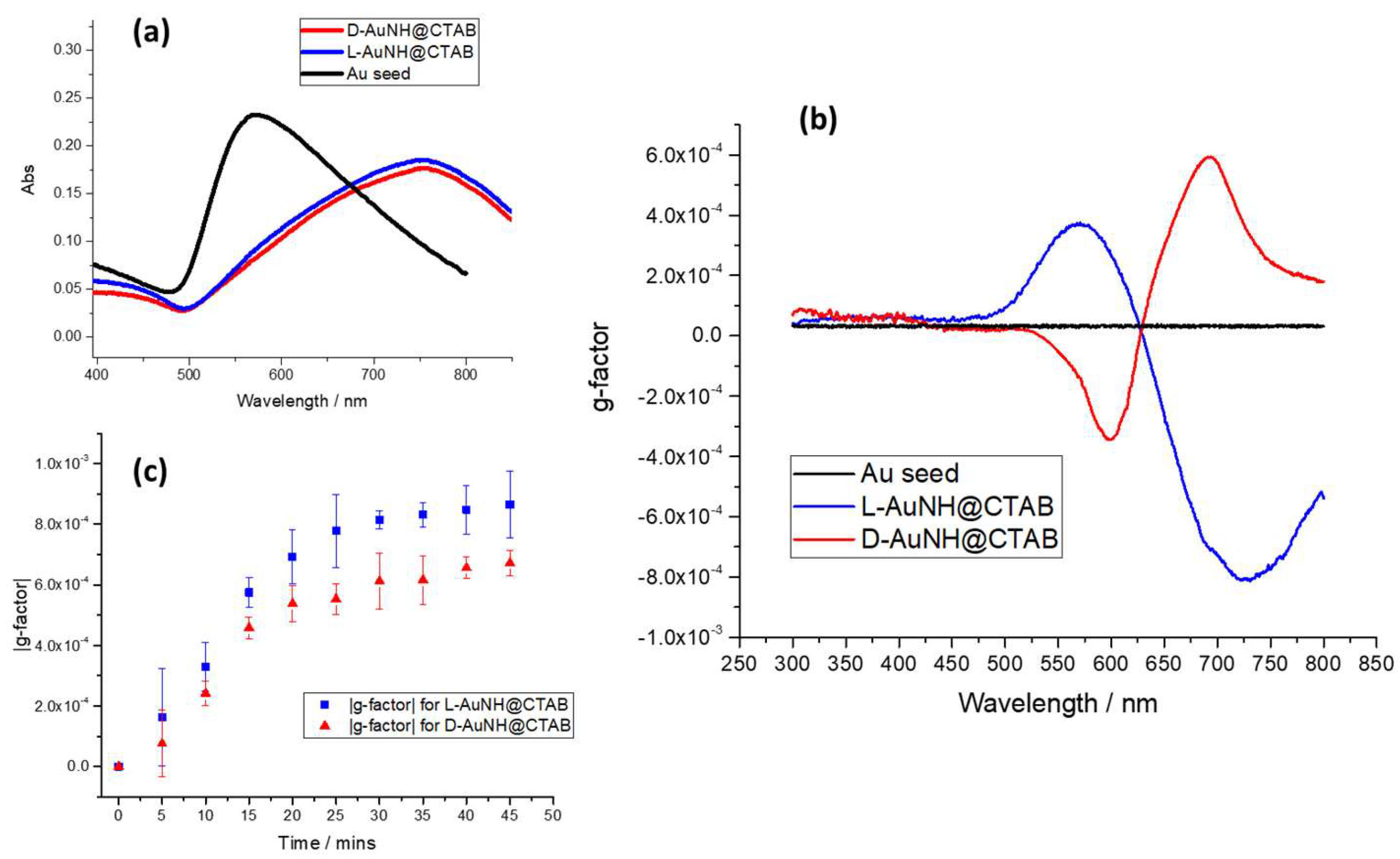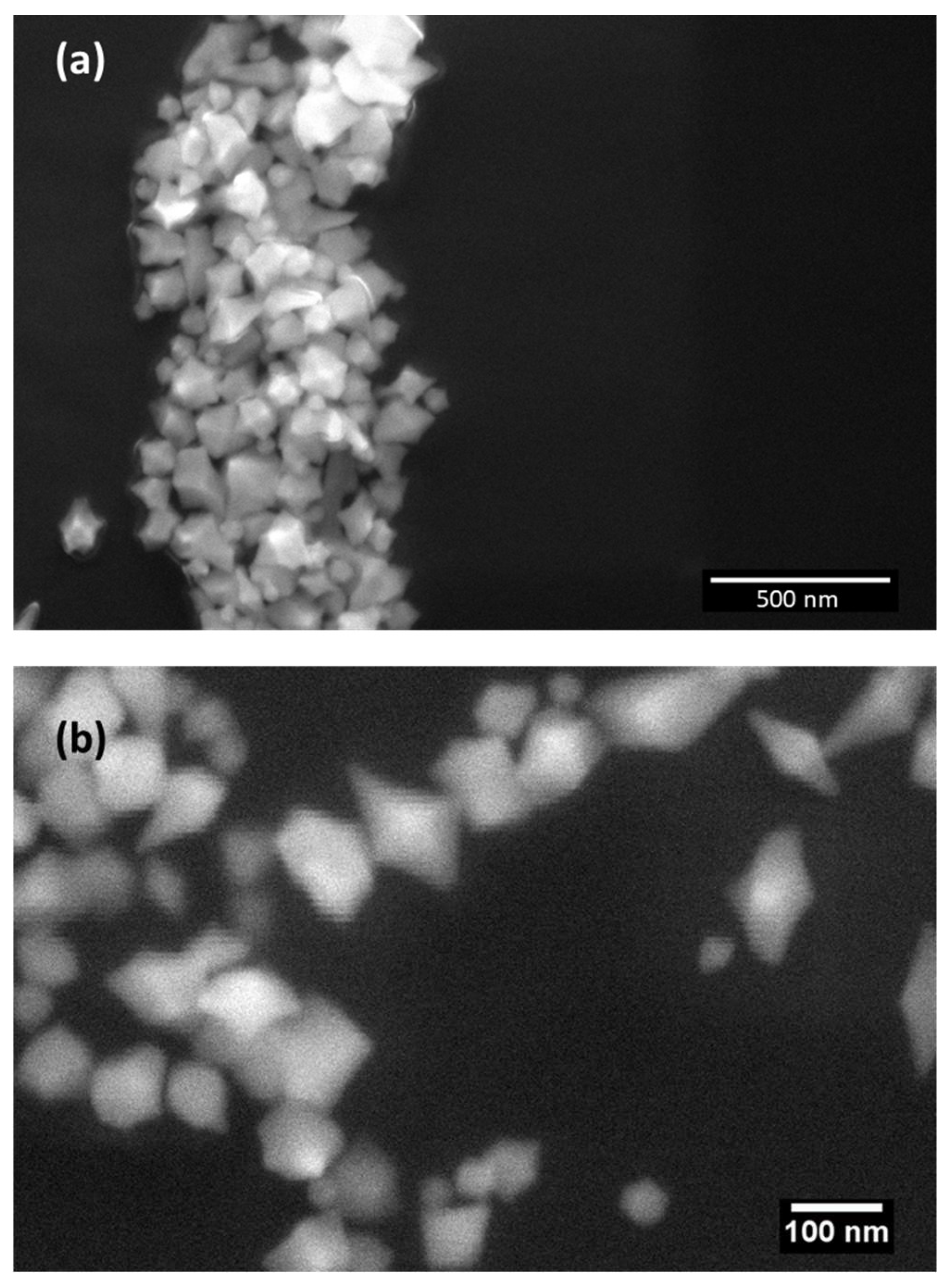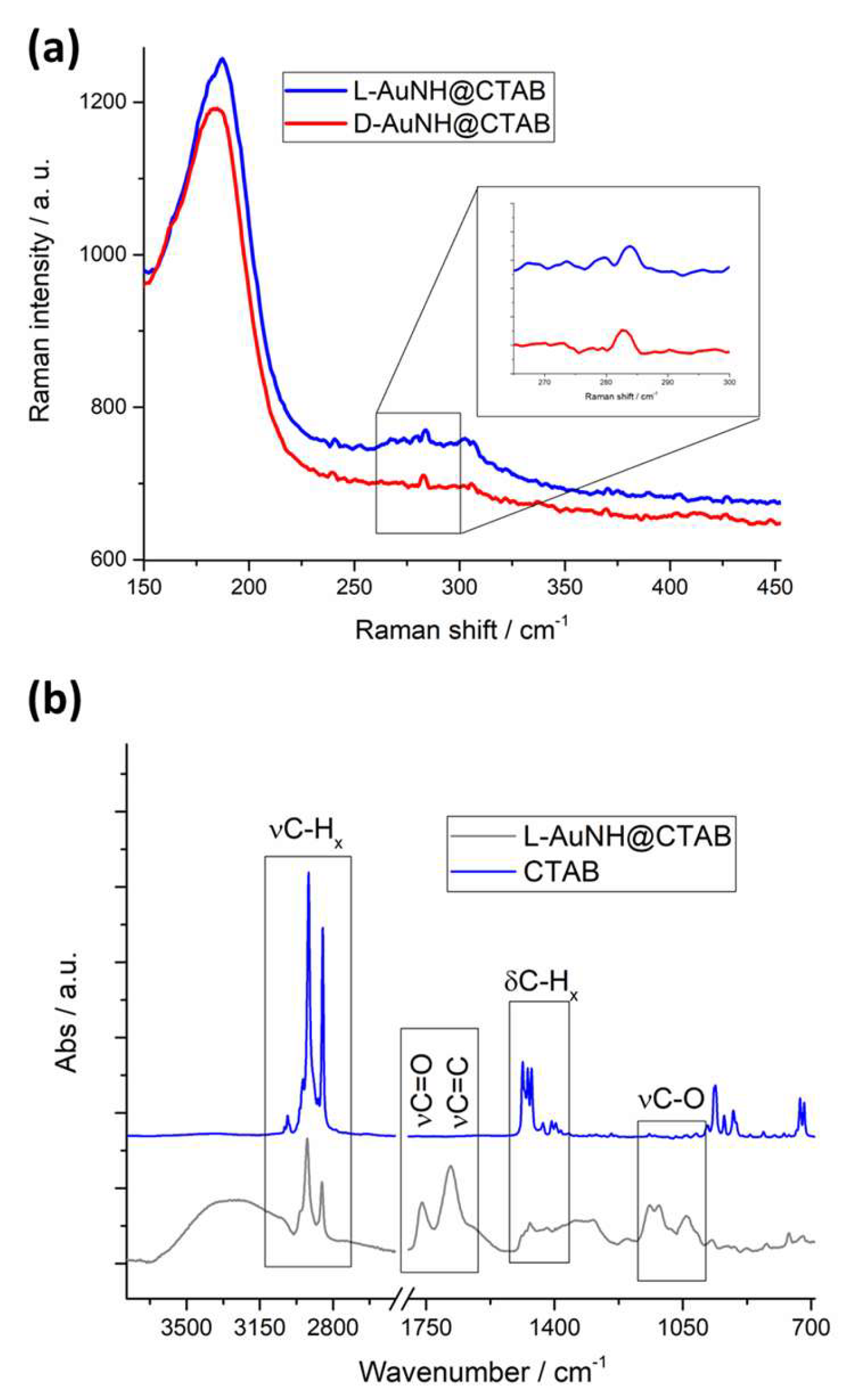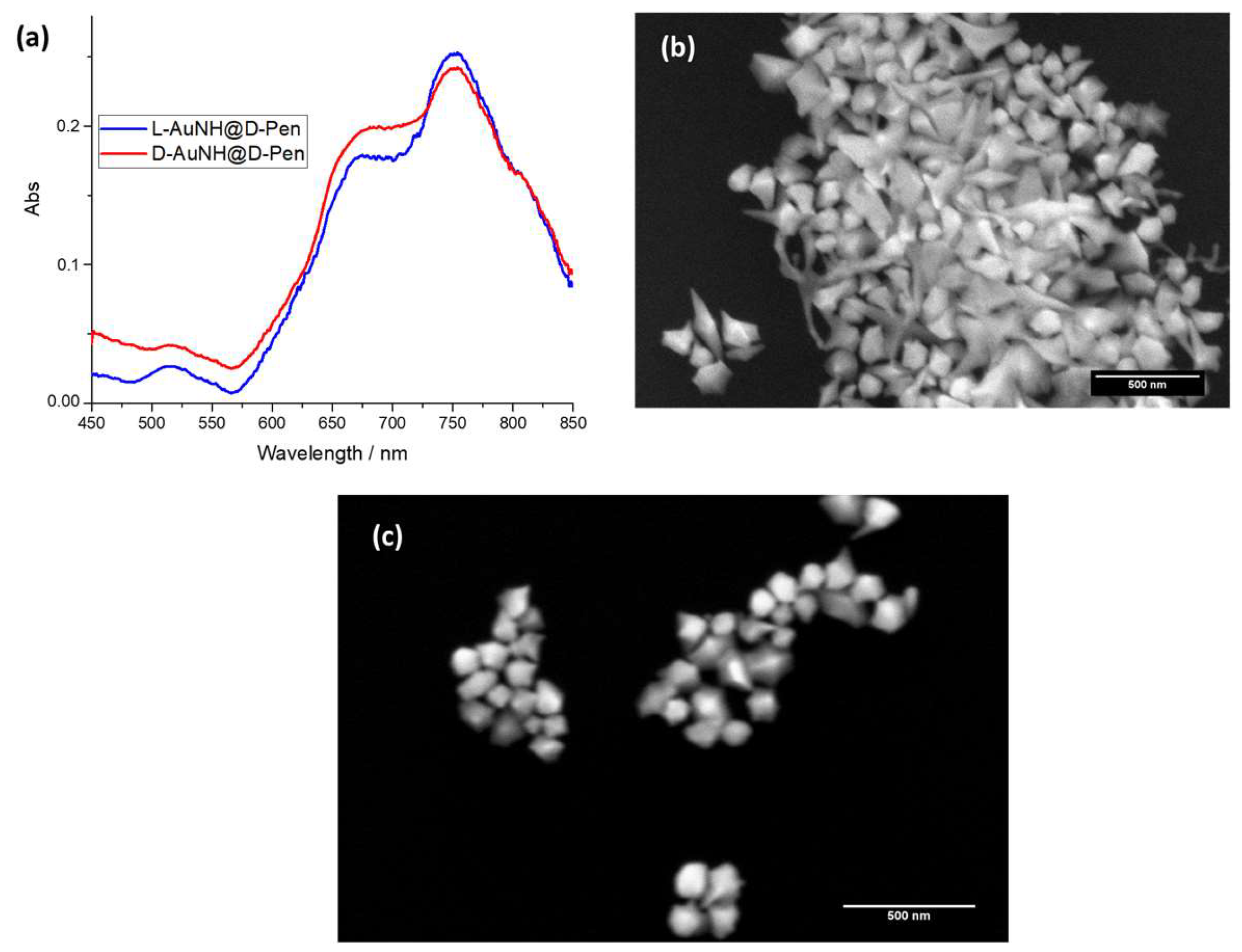Synthesis and Characterization of Gold Chiral Nanoparticles Functionalized by a Chiral Drug
Abstract
1. Introduction
2. Materials and Methods
2.1. Materials
2.2. Chiral AuNP Synthesis Procedure
2.3. D- and L-Penicillamine Functionalization of Chiral Gold Nanostructures
2.4. Characterization Methods
3. Results and Discussion
3.1. Spectroscopic and Morphologic Characterization of L- and D-AuNH@CTAB
3.2. Spectroscopic and Morphologic Characterization of D-Penicillamine-Capped AuNPs
4. Conclusions
Supplementary Materials
Author Contributions
Funding
Data Availability Statement
Conflicts of Interest
References
- Adawy, A. Functional Chirality: From Small Molecules to Supramolecular Assemblies. Symmetry 2022, 14, 292. [Google Scholar] [CrossRef]
- Barron, L.D. An Introduction to Chirality at the Nanoscale. In Chirality at the Nanoscale; Amabilino, D.B., Ed.; Wiley-VCH Verlag GmbH & Co. KGaA: Weinheim, Germany, 2009; pp. 1–27. ISBN 978-3-527-62534-5. [Google Scholar]
- Fan, Y.; Ou-yang, S.; Zhou, D.; Wei, J.; Liao, L. Biological Applications of Chiral Inorganic Nanomaterials. Chirality 2022, 34, 760–781. [Google Scholar] [CrossRef] [PubMed]
- Kim, J.-Y.; Kotov, N.A. Origin of Chiroptical Activity in Nanorod Assemblies. Science 2019, 365, 1378–1379. [Google Scholar] [CrossRef] [PubMed]
- Zhao, X.; Zang, S.-Q.; Chen, X. Stereospecific Interactions between Chiral Inorganic Nanomaterials and Biological Systems. Chem. Soc. Rev. 2020, 49, 2481–2503. [Google Scholar] [CrossRef]
- Zhao, L.; Zhou, Y.; Niu, G.; Gao, F.; Sun, Z.; Li, H.; Jiang, Y. Advances in Chiral Gold Nano-Assemblies and Their Bioapplication Based on Optical Properties. Part Part. Syst. Charact. 2022, 39, 2100231. [Google Scholar] [CrossRef]
- Zhao, B.; Yang, S.; Deng, J.; Pan, K. Chiral Graphene Hybrid Materials: Structures, Properties, and Chiral Applications. Adv. Sci. 2021, 8, 2003681. [Google Scholar] [CrossRef]
- Li, H.; Gao, X.; Zhang, C.; Ji, Y.; Hu, Z.; Wu, X. Gold-Nanoparticle-Based Chiral Plasmonic Nanostructures and Their Biomedical Applications. Biosensors 2022, 12, 957. [Google Scholar] [CrossRef]
- Xu, Z.; Qu, A.; Zhang, H.; Wang, W.; Hao, C.; Lu, M.; Shi, B.; Xu, L.; Sun, M.; Xu, C.; et al. Photoinduced Elimination of Senescent Microglia Cells in Vivo by Chiral Gold Nanoparticles. Chem. Sci. 2022, 13, 6642–6654. [Google Scholar] [CrossRef]
- Hooftman, A.; O’Neill, L.A.J. Nanoparticle Asymmetry Shapes an Immune Response. Nature 2022, 601, 323–325. [Google Scholar] [CrossRef]
- Kang, X.; Wang, Y.; Cai, X.-L.; Hua, Y.; Shao, Z.-H.; Chen, X.; Zhao, X.; Zang, S.-Q. Chiral Gold Clusters Functionalized Two-Dimensional Nanoparticle Films to Regulate the Adhesion and Differentiation of Stem Cells. J. Colloid. Interface Sci. 2022, 625, 831–838. [Google Scholar] [CrossRef]
- Dutta, S.; Finn, T.S.; Kuhn, A.J.; Abrams, B.; Raskatov, J.A. Chirality Dependence of Amyloid β Cellular Uptake and a New Mechanistic Perspective. ChemBioChem 2019, 20, 1023–1026. [Google Scholar] [CrossRef]
- Fu, P.; Sun, M.; Xu, L.; Wu, X.; Liu, L.; Kuang, H.; Song, S.; Xu, C. A Self-Assembled Chiral-Aptasensor for ATP Activity Detection. Nanoscale 2016, 8, 15008–15015. [Google Scholar] [CrossRef]
- Sun, M.; Xu, L.; Bahng, J.H.; Kuang, H.; Alben, S.; Kotov, N.A.; Xu, C. Intracellular Localization of Nanoparticle Dimers by Chirality Reversal. Nat. Commun. 2017, 8, 1847. [Google Scholar] [CrossRef]
- Zhang, N.-N.; Sun, H.-R.; Liu, S.; Xing, Y.-C.; Lu, J.; Peng, F.; Han, C.-L.; Wei, Z.; Sun, T.; Yang, B.; et al. Gold Nanoparticle Enantiomers and Their Chiral-Morphology Dependence of Cellular Uptake. CCS Chem. 2021, 4, 660–670. [Google Scholar] [CrossRef]
- Liu, J.; He, H.; Xiao, D.; Yin, S.; Ji, W.; Jiang, S.; Luo, D.; Wang, B.; Liu, Y. Recent Advances of Plasmonic Nanoparticles and Their Applications. Materials 2018, 11, 1833. [Google Scholar] [CrossRef]
- Krajczewski, J.; Kołątaj, K.; Kudelski, A. Plasmonic Nanoparticles in Chemical Analysis. RSC Adv. 2017, 7, 17559–17576. [Google Scholar] [CrossRef]
- Hamed, M.S.G.; Ike, J.N.; Mola, G.T. Plasmonic Nano-Particles Mediated Energy Harvesting in Thin-Film Organic Solar Cells. J. Phys. D Appl. Phys. 2022, 55, 015102. [Google Scholar] [CrossRef]
- Bettini, S.; Pagano, R.; Semeraro, P.; Ottolini, M.; Salvatore, L.; Marzo, F.; Lovergine, N.; Giancane, G.; Valli, L. SiO2-Coated ZnO Nanoflakes Decorated with Ag Nanoparticles for Photocatalytic Water Oxidation. Chem. Eur. J. 2019, 25, 14123. [Google Scholar] [CrossRef]
- Da Silva, A.G.M.; Rodrigues, T.S.; Wang, J.; Camargo, P.H.C. Plasmonic Catalysis with Designer Nanoparticles. Chem. Commun. 2022, 58, 2055–2074. [Google Scholar] [CrossRef]
- Li, Y.; Tantiwanichapan, K.; Swan, A.K.; Paiella, R. Graphene Plasmonic Devices for Terahertz Optoelectronics. Nanophotonics 2020, 9, 1901–1920. [Google Scholar] [CrossRef]
- Cao, Y.; Li, J.; Sun, M.; Liu, H.; Xia, L. Nonlinear Optical Microscopy and Plasmon Enhancement. Nanomaterials 2022, 12, 1273. [Google Scholar] [CrossRef] [PubMed]
- Colombelli, A.; Manera, M.G.; Borovkov, V.; Giancane, G.; Valli, L.; Rella, R. Enhanced Sensing Properties of Cobalt Bis-Porphyrin Derivative Thin Films by a Magneto-Plasmonic-Opto-Chemical Sensor. Sens. Actuators B Chem. 2017, 246, 1039–1048. [Google Scholar] [CrossRef]
- Reinhard, I.; Miller, K.; Diepenheim, G.; Cantrell, K.; Hall, W.P. Nanoparticle Design Rules for Colorimetric Plasmonic Sensors. ACS Appl. Nano Mater. 2020, 3, 4342–4350. [Google Scholar] [CrossRef]
- Buccolieri, A.; Bettini, S.; Salvatore, L.; Baldassarre, F.; Ciccarella, G.; Giancane, G. Sub-Nanomolar Detection of Biogenic Amines by SERS Effect Induced by Hairy Janus Silver Nanoparticles. Sens. Actuators B Chem. 2018, 267, 265–271. [Google Scholar] [CrossRef]
- Pagano, R.; Ottolini, M.; Valli, L.; Bettini, S.; Giancane, G. Ag Nanodisks Decorated Filter Paper as a SERS Platform for Nanomolar Tetracycline Detection. Colloids Surf. A Physicochem. Eng. Asp. 2021, 624, 126787. [Google Scholar] [CrossRef]
- Fatrekar, A.P.; Morajkar, R.; Krishnan, S.; Dusane, A.; Madhyastha, H.; Vernekar, A.A. Delineating the Role of Tailored Gold Nanostructures at the Biointerface. ACS Appl. Bio Mater. 2021, 4, 8172–8191. [Google Scholar] [CrossRef]
- Ahmed, S.; Annu; Ikram, S.; Yudha, S. Biosynthesis of Gold Nanoparticles: A Green Approach. J. Photochem. Photobiol. B Biol. 2016, 161, 141–153. [Google Scholar] [CrossRef]
- Bailly, A.-L.; Correard, F.; Popov, A.; Tselikov, G.; Chaspoul, F.; Appay, R.; Al-Kattan, A.; Kabashin, A.V.; Braguer, D.; Esteve, M.-A. In Vivo Evaluation of Safety, Biodistribution and Pharmacokinetics of Laser-Synthesized Gold Nanoparticles. Sci. Rep. 2019, 9, 12890. [Google Scholar] [CrossRef]
- Ko, W.-C.; Wang, S.-J.; Hsiao, C.-Y.; Hung, C.-T.; Hsu, Y.-J.; Chang, D.-C.; Hung, C.-F. Pharmacological Role of Functionalized Gold Nanoparticles in Disease Applications. Molecules 2022, 27, 1551. [Google Scholar] [CrossRef]
- Pagano, R.; Syrgiannis, Z.; Bettini, S.; Ingrosso, C.; Valli, L.; Giancane, G.; Prato, M. Localized and Surface Plasmons Coupling for Ultrasensitive Dopamine Detection by Means of SPR-Based Perylene Bisimide/Au Nanostructures Thin Film. Adv. Mater. Interfaces 2021, 8, 2101023. [Google Scholar] [CrossRef]
- Si, P.; Razmi, N.; Nur, O.; Solanki, S.; Pandey, C.M.; Gupta, R.K.; Malhotra, B.D.; Willander, M.; de la Zerda, A. Gold nanomaterials for optical biosensing and bioimaging. Nanoscale Adv. 2021, 3, 2679–2698. [Google Scholar] [CrossRef]
- Noireaux, J.; Grall, R.; Hullo, M.; Chevillard, S.; Oster, C.; Brun, E.; Sicard-Roselli, C.; Loeschner, K.; Fisicaro, P. Gold Nanoparticle Uptake in Tumor Cells: Quantification and Size Distribution by Sp-ICPMS. Separations 2019, 6, 3. [Google Scholar] [CrossRef]
- Zhao, C.; Qiu, L.; Lv, P.; Han, A.; Fang, G.; Liu, J.; Wang, S. AuNP-Peptide Probe for Caspase-3 Detection in Living Cells by SERS. Analyst 2019, 144, 1275–1281. [Google Scholar] [CrossRef]
- Tan, G.; Onur, M.A. Cellular Localization and Biological Effects of 20nm-Gold Nanoparticles: Biological Effects of 20nm-Gold Nanoparticles. J. Biomed. Mater. Res. 2018, 106, 1708–1721. [Google Scholar] [CrossRef]
- Yue, J.; Feliciano, T.J.; Li, W.; Lee, A.; Odom, T.W. Gold Nanoparticle Size and Shape Effects on Cellular Uptake and Intracellular Distribution of SiRNA Nanoconstructs. Bioconjugate Chem. 2017, 28, 1791–1800. [Google Scholar] [CrossRef]
- Hentschel, M.; Schäferling, M.; Duan, X.; Giessen, H.; Liu, N. Chiral Plasmonics. Sci. Adv. 2017, 3, e1602735. [Google Scholar] [CrossRef]
- Lan, X.; Wang, Q. Self-Assembly of Chiral Plasmonic Nanostructures. Adv. Mater. 2016, 28, 10499–10507. [Google Scholar] [CrossRef]
- Lee, H.-E.; Ahn, H.-Y.; Mun, J.; Lee, Y.Y.; Kim, M.; Cho, N.H.; Chang, K.; Kim, W.S.; Rho, J.; Nam, K.T. Amino-Acid- and Peptide-Directed Synthesis of Chiral Plasmonic Gold Nanoparticles. Nature 2018, 556, 360–365. [Google Scholar] [CrossRef]
- Litwin, T.; Członkowska, A.; Socha, P. Chapter 34—Oral Chelator Treatment of Wilson Disease: D-Penicillamine. In Clinical and Translational Perspectives on Wilson Disease; Kerkar, N., Roberts, E.A., Eds.; Academic Press: Cambridge, MA, USA, 2019; pp. 357–364. ISBN 978-0-12-810532-0. [Google Scholar]
- Delangle, P.; Mintz, E. Chelation Therapy in Wilson’s Disease: From D-Penicillamine to the Design of Selective Bioinspired Intracellular Cu(I) Chelators. Dalton Trans. 2012, 41, 6359–6370. [Google Scholar] [CrossRef]
- Walshe, J.M. Penicillamine Neurotoxicity: An Hypothesis. ISRN Neurol. 2011, 2011, 464572. [Google Scholar] [CrossRef]
- Ahn, H.-Y.; Lee, H.-E.; Jin, K.; Nam, K.T. Extended Gold Nano-Morphology Diagram: Synthesis of Rhombic Dodecahedra Using CTAB and Ascorbic Acid. J. Mater. Chem. C 2013, 1, 6861. [Google Scholar] [CrossRef]
- Lee, H.-E.; Kim, R.M.; Ahn, H.-Y.; Lee, Y.Y.; Byun, G.H.; Im, S.W.; Mun, J.; Rho, J.; Nam, K.T. Cysteine-Encoded Chirality Evolution in Plasmonic Rhombic Dodecahedral Gold Nanoparticles. Nat. Commun. 2020, 11, 263. [Google Scholar] [CrossRef] [PubMed]
- Kowalska, N.; Bandalewicz, F.; Kowalski, J.; Gómez-Graña, S.; Bagiński, M.; Pastoriza-Santos, I.; Grzelczak, M.; Matraszek, J.; Pérez-Juste, J.; Lewandowski, W. Hydrophobic Gold Nanoparticles with Intrinsic Chirality for the Efficient Fabrication of Chiral Plasmonic Nanocomposites. ACS Appl. Mater. Interfaces 2022, 14, 50013–50023. [Google Scholar] [CrossRef] [PubMed]
- Bettini, S.; Ottolini, M.; Pagano, R.; Pal, S.; Licciulli, A.; Valli, L.; Giancane, G. Coffee Grounds-Derived CNPs for Efficient Cr(VI) Water Remediation. Nanomaterials 2021, 11, 1064. [Google Scholar] [CrossRef] [PubMed]
- Quan, Z.; Wang, Y.; Fang, J. High-Index Faceted Noble Metal Nanocrystals. Acc. Chem. Res. 2013, 46, 191–202. [Google Scholar] [CrossRef]
- Luo, S.; Nie, X.; Yang, M.; Fu, Y.; Zeng, P.; Wan, Q. Sorption of Differently Charged Gold Nanoparticles on Synthetic Pyrite. Minerals 2018, 8, 428. [Google Scholar] [CrossRef]
- Pardehkhorram, R.; Bonaccorsi, S.; Zhu, H.; Gonçales, V.R.; Wu, Y.; Liu, J.; Lee, N.A.; Tilley, R.D.; Gooding, J.J. Intrinsic and Well-Defined Second Generation Hot Spots in Gold Nanobipyramids versus Gold Nanorods. Chem. Commun. 2019, 55, 7707–7710. [Google Scholar] [CrossRef]
- Yao, G.; Huang, Q. DFT and SERS Study of L-Cysteine Adsorption on the Surface of Gold Nanoparticles. J. Phys. Chem. C 2018, 122, 15241–15251. [Google Scholar] [CrossRef]
- Su, G.; Yang, C.; Zhu, J.-J. Fabrication of Gold Nanorods with Tunable Longitudinal Surface Plasmon Resonance Peaks by Reductive Dopamine. Langmuir 2015, 31, 817–823. [Google Scholar] [CrossRef]
- Yohannan Panicker, C.; Tresa Varghese, H.; Philip, D. FT-IR, FT-Raman and SERS Spectra of Vitamin C. Spectrochim. Acta Part A Mol. Biomol. Spectrosc. 2006, 65, 802–804. [Google Scholar] [CrossRef]
- Amendola, V.; Pilot, R.; Frasconi, M.; Maragò, O.M.; Iatì, M.A. Surface Plasmon Resonance in Gold Nanoparticles: A Review. J. Phys. Condens. Matter. 2017, 29, 203002. [Google Scholar] [CrossRef]







Disclaimer/Publisher’s Note: The statements, opinions and data contained in all publications are solely those of the individual author(s) and contributor(s) and not of MDPI and/or the editor(s). MDPI and/or the editor(s) disclaim responsibility for any injury to people or property resulting from any ideas, methods, instructions or products referred to in the content. |
© 2023 by the authors. Licensee MDPI, Basel, Switzerland. This article is an open access article distributed under the terms and conditions of the Creative Commons Attribution (CC BY) license (https://creativecommons.org/licenses/by/4.0/).
Share and Cite
Bettini, S.; Ottolini, M.; Valli, D.; Pagano, R.; Ingrosso, C.; Roeffaers, M.; Hofkens, J.; Valli, L.; Giancane, G. Synthesis and Characterization of Gold Chiral Nanoparticles Functionalized by a Chiral Drug. Nanomaterials 2023, 13, 1526. https://doi.org/10.3390/nano13091526
Bettini S, Ottolini M, Valli D, Pagano R, Ingrosso C, Roeffaers M, Hofkens J, Valli L, Giancane G. Synthesis and Characterization of Gold Chiral Nanoparticles Functionalized by a Chiral Drug. Nanomaterials. 2023; 13(9):1526. https://doi.org/10.3390/nano13091526
Chicago/Turabian StyleBettini, Simona, Michela Ottolini, Donato Valli, Rosanna Pagano, Chiara Ingrosso, Maarten Roeffaers, Johan Hofkens, Ludovico Valli, and Gabriele Giancane. 2023. "Synthesis and Characterization of Gold Chiral Nanoparticles Functionalized by a Chiral Drug" Nanomaterials 13, no. 9: 1526. https://doi.org/10.3390/nano13091526
APA StyleBettini, S., Ottolini, M., Valli, D., Pagano, R., Ingrosso, C., Roeffaers, M., Hofkens, J., Valli, L., & Giancane, G. (2023). Synthesis and Characterization of Gold Chiral Nanoparticles Functionalized by a Chiral Drug. Nanomaterials, 13(9), 1526. https://doi.org/10.3390/nano13091526












